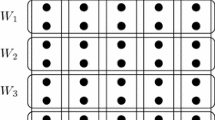Abstract
Many different divisible designs are already known. Some of them possess remarkable automorphism groups, so called dual translation groups. The existence of such an automorphism group enables us to characterize its associated divisible design as being isomorphic to a substructure of a finite affine space.
Similar content being viewed by others
References
André J (1954) Über nicht-Desarguessche Ebenen mit transitiver Translationsgruppe. Math Z 60:156–186
Blunck A, Havlicek H, Zanella C (2007) Lifting of divisible designs. Designs, Codes and Cryptography 42:1–14
Cerroni C, Schulz R-H (2000) Divisible designs admitting GL(3, q) as an automorphism group. Geom Dedicata 83:343–350
Cerroni C, Schulz R-H (2001) Divisible designs admitting, as an automorphism group, an orthogonal group or a unitary group. In: Jungnickel D. et al (eds) Finite fields and applications, Springer, Verlag, Berlin, pp. 95–108. Proc. 5th internat. conf. on finite fields and applications
Cerroni C, Spera AG (1999) On divisible designs and twisted field planes. J Comb Des 7:453–464
Giese S (2005) Block-zerlegbare divisible Designs. URL: http://www.diss.fu-berlin.de/2005/347, Dissertation
Giese S (2006) Block-decomposability of divisible designs. Submitted to J Comb Des
Giese S (2006) Constructing block-decomposable divisible designs. Preprint
Giese S, Havlicek H, Schulz R-H (2005) Some constructions of divisible designs from Laguerre geometries. Discrete Math 301:74–82
Lüneburg H (1980) Translation planes. Springer, New York
Schulz R-H (1985) On the classification of translation group-divisible designs. Euro. J. Comb 6:369–374
Schulz R-H (1987) On translation transversal designs with λ > 1. Arch. Math 49:97–102
Schulz R-H, Spera AG (1998) Construction of divisible designs from translation planes. Eur. J. Comb 19(4):479–486
Schulz R-H, Spera AG (1998) Divisible designs admitting a Suzuki group as an automorphism group. Boll. Unione Mat Ital 8(1B):705–714
Spera AG (1992) t-Divisible designs from imprimitive permutation groups. Eur. J. Comb 13:409–417
Spera AG (2000) Divisible designs associated with translation planes admitting a 2-transitive collineation group on the points at infinity. Aequationes Math 59(1–2):191–200
Stroppel M (1992) Reconstruction of incidence geometries from groups of automorphisms. Arch. Math 58:621–624
Author information
Authors and Affiliations
Corresponding author
Additional information
Communicated by A. Pott.
Rights and permissions
About this article
Cite this article
Giese, S., Schulz, RH. Divisible designs with dual translation group. Des Codes Crypt 43, 41–45 (2007). https://doi.org/10.1007/s10623-007-9056-7
Received:
Revised:
Accepted:
Published:
Issue Date:
DOI: https://doi.org/10.1007/s10623-007-9056-7



